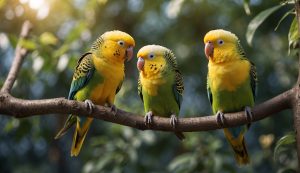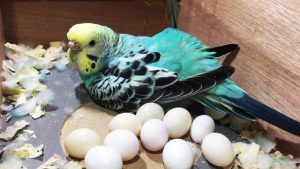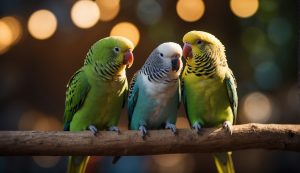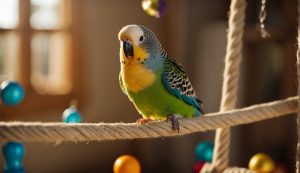My Parakeets Keep Fighting: How to Restore Harmony in Your Aviary

Parakeets are social and highly interactive birds, popular as pets for their vibrant colors and engaging personalities. However, like any social creature, conflicts can arise, particularly when multiple birds are kept together.
When parakeets fight, it’s often a clear sign that something within their environment or interactions isn’t aligning with their natural behavior or needs.
Understanding why these tiny birds engage in conflict is essential for creating a peaceful and healthy environment for them.
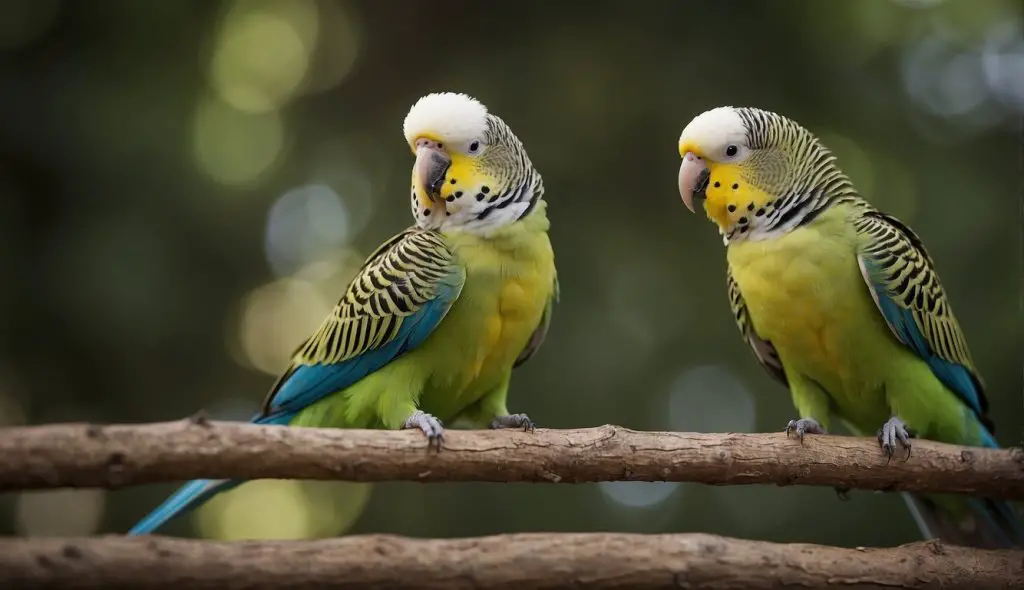
It’s important to observe the behavior of parakeets to discern the triggers for their aggression.
Aggressive conduct may stem from competition over resources, the desire for dominance, or a response to stress or overcrowding.
Offering a well-balanced diet, ensuring they have enough space, and providing enrichment can reduce tensions.
In cases where behavioral adjustments and environmental enrichments don’t resolve the conflicts, seeking advice from a veterinarian experienced in avian health is crucial. They can help address any underlying health issues or give tailored advice on managing your feathery friends’ skirmishes.
Key Points
- Parakeet fights often signal environmental or social stressors.
- Proper care and attention to diet can mitigate aggressive behaviors.
- Consult a veterinarian if persistent aggression occurs.
Table of Contents
How to Understand Parakeet Behavior
Understanding parakeet behavior, especially regarding aggression, requires observing their social interactions and mating signals.
These behaviors are often influenced by social hierarchy, territorial disputes, and hormonal changes within the parakeet community. By recognizing their body language, we can better interpret their actions and needs.
Social Hierarchy and Territorial Behavior
Parakeets are inherently social birds that thrive in a structured environment. They establish a social hierarchy that determines their interactions and behaviors with each other. Here are some key aspects to understand:
- Dominance: The dominant bird often claims the best perches or feeding spots.
- Territory: Parakeets defend their perceived territory vigorously. Signs of aggression such as biting, chasing, or loud vocalizations usually indicate a territorial dispute.
When I observe parakeets in social groups, I pay close attention to changes in their body language and vocal patterns, which often signal shifts in their social standings or territorial boundaries.
Mating and Breeding Signals
Mating rituals are a significant part of parakeet behavior. During these times, aggressive behavior can also increase due to hormonal imbalances. Here’s what you might notice:
- Courting: Courtship often involves tail fanning, head bobbing, and presenting of food.
- Aggression: Males can become more aggressive, guarding their chosen mate against rivals.
When I study mating behavior, I make sure to differentiate between normal courtship displays and aggression induced by hormonal changes. Aggression during these periods is typically more pronounced and can lead to duelling or fights between males competing for a partner.
Things that can cause Aggression in Parakeets
In my experience with parakeets, I’ve noticed that aggression can often be a sign of underlying issues. Two major factors that can trigger this behavior are environmental stressors and physical health concerns.
Environmental Stressors
Space and Territory: Parakeets are highly territorial. If their space feels cramped or they’re sharing it with too many others, aggression can surface. Ensuring enough room can help reduce territorial disputes.
- Food and Water Resources: A lack of adequate food and water can lead to competition and aggression among parakeets. It’s important to provide multiple feeding and watering spots to alleviate this stress.
Next, I make sure to provide environmental enrichments to prevent boredom and malnutrition, which can also lead to aggression.
- Toys: The absence of stimulating toys can result in boredom and aggression.
- Diet: An imbalanced diet lacking essentials such as vitamin B can contribute to stress behaviors. Ensure a rich and varied diet.
Physical Health Concerns
Disease and Discomfort: Physical ailments can make parakeets irritable and aggressive. Regular health check-ups are necessary to keep them in good shape.
Nutrition:
- Vitamin Deficiency: A deficiency in vitamins, especially vitamin B, can lead to health issues that may manifest as aggression.
- Diet: Incorrect diet can cause health problems, which in turn can increase aggressive behavior in parakeets.
Preventing and Handling Fights
In my experience with parakeets, I’ve found that preventing fights is just as crucial as knowing how to intervene when they do occur. Let’s dive into the specifics of creating a harmonious environment and what to do if a skirmish breaks out.
Proper Cage Setup
My first piece of advice is to ensure the cage is set up properly. Parakeets need plenty of room, so providing enough space is essential.
I always suggest having multiple perches to give each bird its own space and help prevent squabbles over favorite spots. Here’s a checklist to ensure the cage setup is conducive to a peaceful cohabitation:
- Size of Cage: At least 18 x 18 x 24 inches for a pair; larger for more birds.
- Number of Perches: At least 2-3, spaced out to allow each bird its own territory.
- Toys and Activities: Provide a variety of toys to keep the birds entertained and engaged. Boredom can lead to aggression.
Using positive reinforcement techniques can also encourage harmony within the cage. I reward my parakeets with treats when they play nicely, reinforcing good behavior.
Intervening in Fights
Even in the best circumstances, I’ve had to intervene in fights. If you notice your parakeets fighting, it’s important to act quickly but calmly.
Separating them temporarily into separate cages can help. Here’s my step-by-step approach:
- Observation: Always supervise interactions after reintroducing them.
- Intervention: If a fight breaks out, cover the cage with a blanket to calm them down before separating them.
- After cooling off, reintroduce them under supervision to monitor their behavior.
Remember, separation should be a last resort. It’s always better to prevent fights with the right setup and attention to their needs.
Diet and Nutrition’s Role in Behavior
When I look at my parakeets, I can see how their diet directly affects their behavior.
Proper nutrition is crucial not only for their health but also for their temperament. I’ve learned that a balanced diet can help reduce aggression among these feathery companions.
In my experience, a diet lacking variety tends to make my parakeets more irritable.
Variety is key; it should include seeds, fresh fruits, and vegetables. These foods provide a range of essential nutrients that can influence behavior.
Specifically, vitamin B is vital for their well-being.
It’s not just about physical health; a deficiency in vitamin B can lead to increased aggression and stress in birds.
I make sure to provide a mix that caters to their nutritional needs. Here’s a simple breakdown of what I keep in mind:
| Component | Food Sources | Behavioral Impact |
|---|---|---|
| Seeds | Millet, Sunflower, Safflower | Baseline diet, can cause issues if overfed |
| Fruits | Berries, Apples, Melon | Adds nutritional variety, promotes better mood |
| Vegetables | Spinach, Carrots, Peas | Essential vitamins, can reduce aggression |
| Vitamin B | Leafy greens, Eggs | Needed for nervous system, lack can cause stress |
It’s not just the type of food but also the searching and foraging for it that provides mental stimulation, reducing the likelihood of fighting.
Engaging them with food puzzles or foraging toys has made a noticeable difference in their aggression levels. Keeping their minds active makes them less likely to take their energy out on each other.
When You Should Consult a Veterinarian
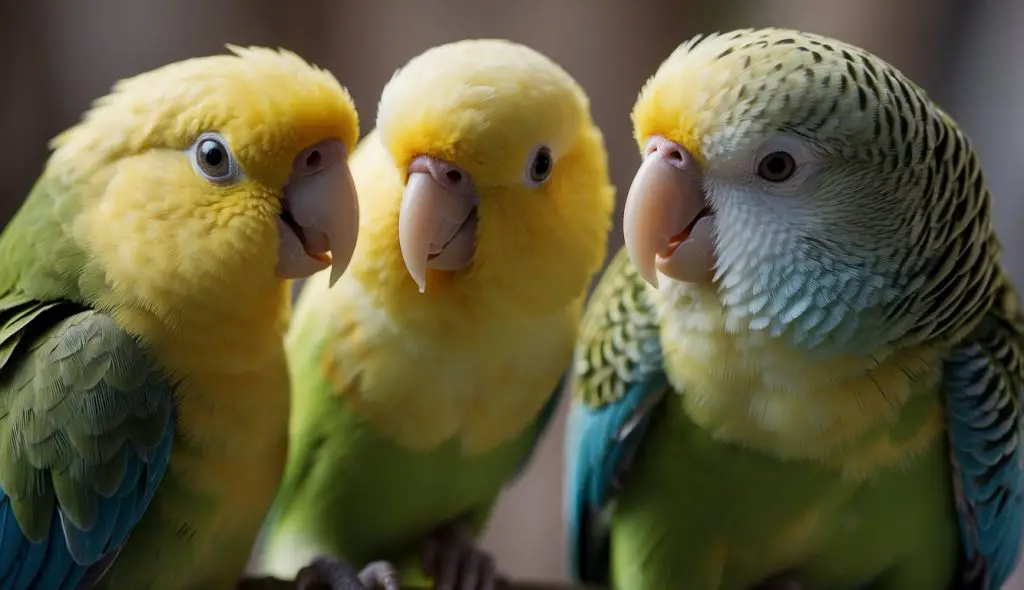
As a parakeet owner, I keep an eye on my feathered friends to ensure they’re healthy and happy. However, there are times when behavior between parakeets can turn aggressive, and it’s crucial to recognize when professional advice is necessary. Here are signs that it’s time to consult an avian veterinarian or an avian specialist:
- Unexplained Injuries: If I notice injuries like feathers being plucked out or wounds on my parakeets, that can be a sign of escalated fighting and a good reason to seek a vet’s opinion.
- Change in Behavior: A parakeet that is normally social but suddenly becomes withdrawn or aggressive may have underlying health issues. I keep an eye out for these behavioral changes and consult with a veterinarian if they persist.
- Feeding Issues: When I see changes in eating habits such as a parakeet who stops eating or struggles to feed, I consider this a red flag and get in touch with an avian specialist.
- Continuous Squawking or Screaming: While some vocalization is normal, excessive noise could be a sign of distress. Persistent squawking could warrant a health check.
- Attempts to Escape or Self-Harm: If a parakeet tries to escape the cage constantly or inflicts harm upon itself, it might be experiencing stress or illness.
Table: When to Consult a Veterinarian
| Behavioral Sign | Action to Take |
|---|---|
| Unexplained Injuries | Contact veterinarian immediately |
| Change in Behavior | Monitor and consult if it continues |
| Feeding Issues | Consult avian specialist |
| Continuous Squawking | Evaluate environment, consult if needed |
| Escape Attempts/Self-Harm | Seek immediate veterinary advice |
Frequently Asked Questions
In my experience, understanding how and why parakeets fight is crucial for their wellbeing. Here’s some clear information to address common concerns about parakeet behavior.
What causes parakeets to start fighting with each other?
I’ve observed that parakeets may fight due to competition for food, territory, or the attention of a mate. Lack of space can also lead to increased aggression among them.
How can budgie owners differentiate between fighting and playing?
When my budgies play, their movements are gentle, and they may softly nibble each other. In contrast, fighting involves more aggressive pecking, chasing, and loud squawking.
What should I do if my parakeets are fighting to the point of drawing blood?
If blood is drawn, it’s critical to separate the parakeets immediately to prevent further injury. Consultation with an avian veterinarian may be necessary to address any wounds or underlying causes.
Can male and female parakeets engage in fights, and if so, why?
Yes, both male and female parakeets can engage in fights. In my experience, this can happen over mating disputes or hierarchical positioning within the group.
What are effective methods to stop my budgies from fighting?
To stop budgies from fighting, I provide numerous food dishes, perches, and toys to reduce competition. Ensuring a spacious cage and sometimes introducing a visual barrier can also help.
How can I tell if my birds are fighting or mating?
Mating typically involves mutual preening and regurgitating food. These are signs of affection. On the other hand, fighting is characterized by biting and aggressive noises.

